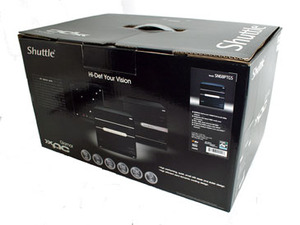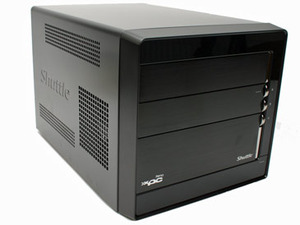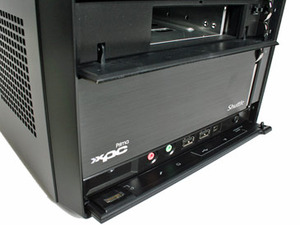Shuttle SP35P2 Pro XPC
Manufacturer: ShuttleUK Price (as reviewed): £293.40 (inc. VAT)
US Price (as reviewed): $419.99 (excl. Tax)
Introduction
Shuttle has continually pushed the boundaries for Small-Form-Factor (SFF) PCs to new levels with its XPC ranges. Every now and again we revisit the range to see what the latest and greatest XPCs are, but in many respects a lot of people have moved back to larger desktop machines because of its limitations in space (inside), overclocking, upgradability and noise.Having seen Shuttle at Computex last summer, we saw it was keen to push its brand forwards again, by attempting to cure a number of these issues as well as maximise the benefits of the small form factor. This year, Shuttle has launched two subsets to its current XPC designs—the Prima and Glamour series—both in a bid to add a bit of prestige to its brand. This is especially the case with the Glamour range, which we initially saw some models adorned with diamond-like plastic bits on the front. Thankfully, Shuttle dropped this tacky, overly feminine concept in preference for a neutral brushed aluminium and chrome look instead.
The SP35P2 Pro is part of the new Prima series, which is tailored to feature “high performance models, for professional and performance demanding applications whether they be at work, everyday or for high-tech gaming.” Back at Computex, there were two models in this series - the SX38P3 Deluxe, based on the Intel X38 chipset, and the SP35P3 Deluxe based on Intel P35. It seems as though Shuttle has dropped the P3 chassis from its line-up, and the SX38P2 offers basically the same features we've already seen and from the looks of things there seems to be very little reason to buy the SX38P2. Although we can’t just dismiss the SX38P2 without considering price and in that respect there appears to be almost no difference between the two, but very few places have either in stock.
SP35P2 Specifications
- P2 Prima aluminium chassis with one 5.25" optical bay and one 3.5" external bay, room for three 3.5" SATA hard drives
- 400W PSU with one 6-pin PCI-Express plug and 80Plus efficiency certification
- Intel LGA775 socket support for 1,333MHz, 1,066MHz and 800MHz Core 2 Duo, Core 2 Extreme and Core 2 Quad CPUs
- Four DDR2 DIMM slots supporting up to 8GB DDR2-800MHz memory
- Intel P35 north bridge
- Intel ICH9R south bridge
- Four SATA 3Gbps and one IDE port
- One PCI-Express x16 slot that supports Dual-slot (double-width) graphics cards
- One PCI 32 bit slot
- One Mini-PCIe x1 slot for Intel Turbo Memory
- Realtek ALC888DD 7.1 channel High-Definition audio codec
- Marvell 88E8056 PCI-Express Gigabit Ethernet adapter
- ICE CPU and OASIS motherboard cooling systems
- Fingerprint reader
Chassis Overview
The basic case is still an all aluminium affair which keeps the weight down as much as possible but also increases the cost. Shuttle still insists on painting rather than anodising its shell, even though the front bays are brushed and anodised, but this is for looks rather than for its hard-wearing appeal.The P2 chassis is slightly larger than the G, but it's still small enough to be dwarfed by any ATX case. The extra size offers a much better internal layout and greater expansion potential compared to the G chassis. The P2 chassis also looks far better than the original P-series design in our opinion, even if you do lose the integrated card reader. The sides have a few more ventilation holes for airflow, but still have the embossed Shuttle logo in them. Overall, it looks incredibly smart, nicely subtle and well presented - more than we can say of many other chassis once all the hardware goes in.
You still get stealthed drives: a single 5.25" optical drive bay and a 3.5" for a card reader for example, as well as the hidden front ports – combined, these help to keep the look very clean while remaining functional at the same time. The front connectivity includes two USB 2.0, one 4-pin Firewire, a fingerprint reader, a recessed reset button and 3.5mm analogue sockets for headphones and a microphone. The fingerprint reader at the front is a novel addition and one that's very useful given that most XPCs will sit on people's desks beside them. The software running it works well and installation is a breeze, but we found there are a few problems with the reader when you’re using it.
For starters, the software is loaded with activation DRM that restricts you to just five activations. Great... we don't think. Obviously you shouldn't ever upgrade the core components of the XPC, like putting in a new motherboard for example, but there's any number of reasons that this could easily run out. Also, seemingly, the company that makes the software feels that its OEM business with Shuttle could do a little better by bleeding the customer (who has already paid for the functionality) nice and dry.
Next, we found that the reader is not quite as good as others we've used: it often took several attempts for it to get a proper reading and all the while we were a little worried of breaking the panel's plastic hinges as we pressed down.

MSI MPG Velox 100R Chassis Review
October 14 2021 | 15:04













Want to comment? Please log in.